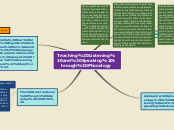Teaching Listening and Speaking through Phonology
Other phonological features
Phonology covers far more than the individual sounds of a language; English is musical and rhythmic, lots of attention is paid to the right syllable and emphasising the right words in sentences.
When a word has more than two syllables in English, one syllable will receive more importance than the others when it is pronounced. This is the syllable that receives the primary word stress. This means that, compared to the other ones, the vowel sound of that syllable will be slightly: louder, longer, at a higher pitch.
Intonation is important, we use pitch variation for many reasons: not only to show our attitude to what we're saying, or to the person we're talking to. Intonation conveys differences of expressive meaning (e.g., surprise, anger, wariness). In many languages, including English, intonation serves a grammatical function, distinguishing one type of phrase or sentence from another.
Addressing phonology in listening and speaking classes
Teaching communicatively means the teacher provides a set of activities that learners need to handle with. Listening and speaking stages during the class help students to make better sense of what they hear or pronounce.
Traditional listening lessons are based around the three stages:
pre-listening
while-listening
post-listening
Tasks that help students to identify phonological features:
count the words in the sentence they hear
mark the pauses, stress and intonation in a brief script accompanying the recording
read along with the recording
Phonology is that branch of linguistics which studies the sound system of languages. It breaks down inti two elements from Greek, meaning "sound" and "study".
Areas of Phonology
Word and sentence stress
Intonation
Connected speech
Phonemes
The International Phonetic Alphabet (IPA)
Symbols are a very useful aid to teaching and learning.
The IPA shows how words are pronounced, it is much better than use the normal alphabet which might cause confusion about how the word is spelt.
There are 44 for both British (BrE) and American English (AmE) with only slight differences between them.
